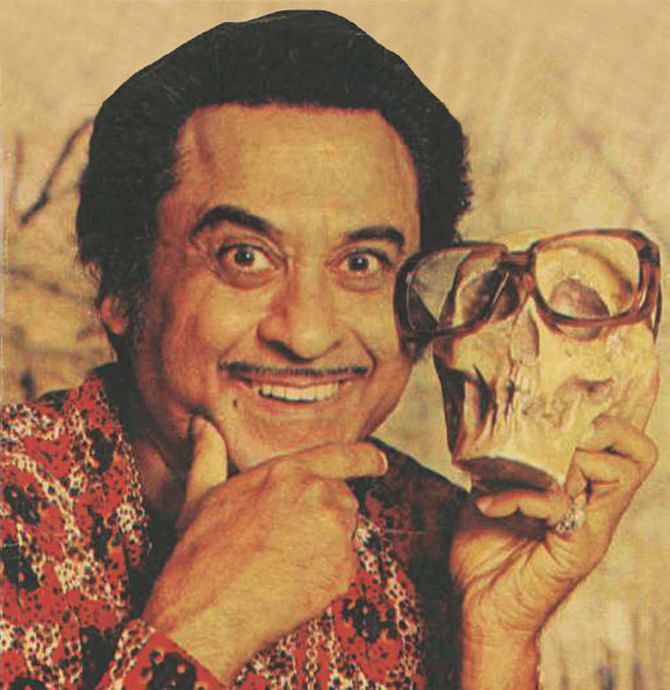The inimitable Kishore'da
The inimitable Kishore'da

When Ashok Kumar stepped into Bollywood and began making a name for himself, his youngest brother Abhas Kumar was still a child. After his other brother Anoop Kumar also ventured into acting, it was probably more the family atmosphere that interested young Abhas into the realm of films. But unlike his brothers, Abhas was more interested in singing, particularly idolising singer-actor KL Saigal. His first steps into Bollywood was as a chorus singer for Bombay Talkies, and although over the next four decades he would go on to act, direct, produce, write scripts and screenplays for films and write and compose songs, it would be his voice that resonated to the furthest corners of the Indian subcontinent.
Although his screen debut “Andolan” (1951) made a lot of people take notice, he kept on looking for singing assignments. Salil Chowdhury, the music director for his 1954 film “Naukri”, was the first to give him a chance with “Chhota Sa Ghar Hoga”, albeit a little apprehensive of the fact that Kishore had no formal musical training. But it took one genius to spot another; when SD Burman heard Kishore imitate KL Saigal, he encouraged him to develop a style of his own. Kishore took it seriously, taking a leaf out of Tex Morton and Jimmie Rodgers' book to add yodeling to his singing.
As his acting career flourished, Kishore went on to produce unforgettable numbers from behind the microphone as well -- “Maana Janaab Ne Pukara Nahin”, “Ek Ladki Bheegi Bhaagi Si”, “Haal Kaisa Hai Janaab Ka” to name just a few; and formed a winning combo with SD Burman and Asha Bhosle for “Chhod Do Aanchal”, “Haal Kaisa Hai Janaab Ka” and “Paanch Rupaiya Baara Aana”. By the '60s, he had also taken producing and directing films, alongside composing, for “Jhumroo” and “Door Gagan Ki Chhaon Mein”. While his acting career took a dip, hits like “Zaroorat Hai Zaroorat Hai”, “Gaata Raahe Mera Dil” and “Yeh Dil Na Hota Bechara” did not stop coming. Late in the decade, he did the unforgettable “Padosan” with Mehmood and Sunil Dutt, and a year later sang “Mere Sapno Ki Raani” and “Roop Tera Mastana” (in “Aradhana”), the song that got him the first of his eight Filmfare Awards, most held by a singer.
Over the next two decades, Kishore Kumar would go on to work with every Bollywood music director of repute, from Lakshmikant-Pyarelal to Bappi Lahiri, was the voice from actors across the strata -- from Amitabh Bachchan to Govinda, shared studio with voices from Lata Mangeshkar to Alisha Chinoy, and sang in languages from Bangla, Marathi, Assamese, Gujarati, Kannada, Bhojpuri, to Malayalam, Oriya, and Urdu.
But there was more to Kishore Kumar that makes him unforgettable. With a broad grin peeking from under the characteristic moustache, he looked like the most jovial person around, but he admitted to being a loner who preferred talking to trees. He was paranoid about being paid; once, upon discovering that his payment was not cleared, he appeared on set with half his face in make-up, and explained to the director “Adha paisa toh adha make-up” (Half payment, half make-up). But for films produced by Rajesh Khanna and Danny Denzongpa, he would not take payment even when offered. There remains countless tales of his eccentricity, from the “Beware of Kishore” sign on his door, to having director GP Sippy chase him on foot while he drove away, only to claim later that Sippy had dreamt of it.
He passed away on October 13, 1987-- his brother Ashok's 76th birthday, of a heart attack, but he sang almost literally till his last day, recording his final song “Guru Guru” the day before. If he had lived, Kishore Kumar would have been 85 yesterday, and probably would still put his headphones on at a studio once in every while, and produced something only he can. Having said that, the songs he sang and the moments he created on screen, are enough to last his fans a lifetime.